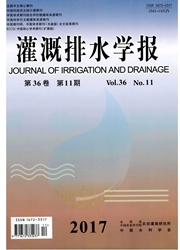

 中文摘要:
中文摘要:
通过温室无土栽培黄瓜不同定植期不同施氮水平试验,分析了不同定植期黄瓜叶片含氮量随生育期的变化规律,以及叶片含氮量与叶片净光合作用速率和产量的定量关系,确定了不同光温条件下黄瓜叶片适宜含氮量的求算方法,以及盛果期黄瓜叶片含氮量与营养液氮素浓度的关系。在此基础上,建立了温室黄瓜无土栽培营养液氮素管理模型。结果表明,叶片适宜含氮量在开花前随生育期推进而增加,到开花期达到最大,开花后叶片适宜含氮量随生育期推进而逐渐降低,到盛果期达到较为稳定的状态。因此,盛果期的叶片含氮量可以作为温室黄瓜氮素管理指标。黄瓜叶片净光合作用速率和产量随盛果期叶片含氮量升高按负指数规律增加,在相同氮浓度的营养液灌溉条件下,春夏茬黄瓜盛果期的叶片适宜含氮量低于秋冬茬,春夏茬和秋冬茬黄瓜盛果期适宜的叶片含氮量分别为3.3%和3.6%,春夏茬和秋冬茬黄瓜无土栽培营养液适宜的氮素浓度分别为124mg/L和96mg/L。
 英文摘要:
英文摘要:
In order to investigate the optimal nitrogen concentration of the nutrient solution for soilless cultivated cucumber crops in greenhouse, experiments with different levels of nitrogen application rate and transplanting dates were conducted in a greenhouse in Shanghai during 2005. The seasonal time course of leaf nitrogen concentration and its relation to the leaf net photosynthesis rate and yield were analyzed. Then, the optimal leaf nitrogen concentration for soilless cultivated cucumber crop in greenhouse in different seasons was determined. Leaf net photosynthesis rate and yield of cucumber were found to be increased exponentially with the leaf nitrogen concentration at the middle fruit harvest stage. The relationship between the leaf nitrogen concentration at the middle fruit harvest stage and the nitrogen concentration of the nutrient solution was then quantified. Based on these quantitative relationships, a management model of nitrogen concentration of the nutrient solution was developed. The results show that during the growing season, the optimal leaf nitrogen concentration reached the peak value at flowering stage. Thereafter, the optimal leaf nitrogen concentration decreased and reached a relative stable level at the middle fruit harvest stage. Therefore, the leaf nitrogen concentration at the middle fruit harvest stage was used as an index for nitrogen management for cucumber crop in greenhouse. The optimal leaf nitrogen concentration at middle fruit harvest stage were 3.3 %, 3.6 %, respectively, for the Spring-Summer season and the Autumn-Winter season and the corresponding optimal nitrogen concentration of the nutrient solution were 124 mg/L and 96 mg/L respectively.
 同期刊论文项目
同期刊论文项目
 同项目期刊论文
同项目期刊论文
 期刊信息
期刊信息
